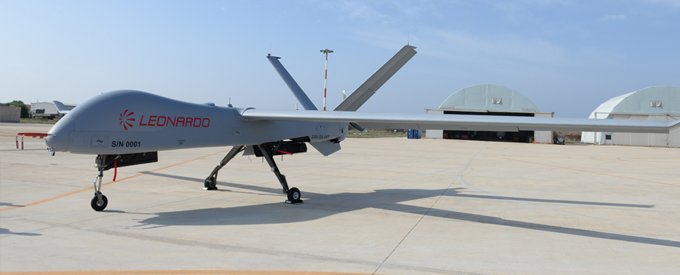2021-04-01
Leonardo Leads the Way in Maritime Surveillance Solutions
Leonardo’s aircraft and sensors are being integrated to support a variety of maritime surveillance missions around the world. For instance, the ATR patrol aircraft fitted with Leonardo sensors and the ATOS mission management system and the Falco family of Unmanned Air Vehicles, are working together to secure the Mediterranean Sea.
A maritime surveillance aircraft flying over the Strait of Sicily, is looking for clues of suspicious activity 200 miles from the coast. The aircraft has just begun its surveillance mission when it, in line with guidelines, is directed to return to base to allow the crew and console operators to rest. It requires hours of further surveillance to collect evidence of unlawful activity at sea, so the crew requests the assistance of a Falco EVO unmanned aircraft capable of conducting missions up to18 hours, with a complete maritime surveillance suite and a satellite connection.
From an altitude of 3,000 feet, the Falco can maintain a distance of six or seven kilometres from its target. Thanks to its high performance electro-optical system and a 43-decibel sonic signature, the unmanned aircraft remains practically invisible to the smugglers. In the hours that follow, the remote-controlled aircraft will collect evidence of illegal activity, documenting every detail of what goes on at sea without allowing its presence to be detected.
This is only one example of the possible synergies between manned aircraft and remote-controlled systems: the interoperability of the two categories and their complementary operational features permits improved efficiency for the most complex surveillance missions.
While on one hand a big, manned patrol craft such as the Guardia di Finanza’s ATR monitoring Italy’s coastline can move three times faster than an unmanned aircraft, unmanned craft have three to four times more persistence pursuing their target. After all, while an ATR can count on a bigger range of sensors and the on-board presence of specialised operators, an unmanned aircraft does not have to consider the issue of crew fatigue, so it has a much greater mission autonomy and can patrol a vast area for hours and hours on end. In both cases, the ground Command and Control Centre can count on valuable information collected in the field and sent from the surveillance platforms in real time. This scenario, repeated at regular intervals in the skies over the Strait of Sicily, is also a clear example of Leonardo’s unique ability to offer complete solutions covering all aspects of surveillance: from unmanned to piloted flight, including sensors and all accessory services permitting execution of the mission.
Given the complexity of modern customers’ requirements, Leonardo is able to deliver a solution that best fits with each customers’ need. The ISR system can be sold as it is, or Leonardo can set up a full service, providing the buyer with exploited information, ready to support the decision makers. The company can also deliver a wide range of service solution, from the dry lease to the pay-for-information, where Leonardo is in charge of any operational aspect from the maintenance to the data exploitation.
Tailored Solutions
In addition to the options described above, there is a great variety of customer specific solutions, tailored on any specific operational need. Leonardo is not only an original equipment manufacturer (OEM) but also a partner of choice to implement the most complex ISR solutions based on internal or third parties’ platforms. The company can deliver completely self-developed solutions as well as fully equipped special missions’ aircraft based on commercial green aircraft integrated with any kind of sensors or mission suites on a one-stop-shop model.
Having know-how in every sector also offers additional benefits: when unmanned aircraft first began to play a role in maritime surveillance, the sensors, especially radar, were too big and heavy as they had been designed for large, manned platforms. Leonardo solved the problem in-house, miniaturising the sensors by reducing their weight, dimensions and power consumption keeping performance constant, or even improving it. One example is the company’s Gabbiano radar system, the weight of which was reduced to less than half that of the 100 kg standard version.
From this development circle, these miniaturised sensors developed for Unmanned Air Vehicles have found an application in another market segment: light manned surveillance craft. Leonardo has signed agreements with a number of light aircraft manufacturers, coming up with small, economical maritime surveillance solutions.


No Comments